To connect any gas-discharge lamps, a ballast is required. Sodium lamps are no exception in this sense; To “warm up” the lamps when turned on and for their normal operation, a ballast will be required. Ballast for sodium lamps– these are ballasts (ballast control gear) or electronic ballasts (electronic ballasts) and IZU (pulse ignition device).
The most common ballasts for sodium lamps are ballast inductive chokes, which are necessary to stabilize and limit the current. The IZU is necessary, as written above, for “warming up” - lighting the lamp. When a sodium lamp is turned on, this device, which is a small unit, delivers a powerful high-voltage pulse to its electrodes, providing a breakdown in gas mixture flasks.
Connection diagrams. Although, sodium lamps today have received quite wide application in a variety of sectors of the economy, due to insufficient transmission of the color spectrum, they are most often used as street lighting.
 These are “street” lamps that replace DRL
, for which console lamps of the brand are produced Housing and communal services. They already have the necessary ballast, properly connected to the lamp, therefore, when using such lamps, the connection is reduced to only supplying the supply voltage to the terminals of the lamp.
These are “street” lamps that replace DRL
, for which console lamps of the brand are produced Housing and communal services. They already have the necessary ballast, properly connected to the lamp, therefore, when using such lamps, the connection is reduced to only supplying the supply voltage to the terminals of the lamp.
To independently assemble a connection diagram for sodium lamps, you will need, as described above, a ballast - a choke and an IZU. Double-winding chokes are considered obsolete today, therefore, when choosing, preference should be given to single-winding ones.
IZU manufacturers produce devices with two and three terminals, therefore, the connection diagram may differ slightly - it, in fact, is depicted on almost every IZU case.

Sodium lamps - consumers reactive power, therefore, in some cases, it makes sense in the absence of phase compensation to include an interference suppression capacitor C in the circuit, which significantly reduces starting current(see photo above).
For throttle DNAT-250 (3A) optimal capacity capacitor – 35 µF, for DNAT-400 (4.4A) – 45 µF. Dry type capacitors should be used, with rated voltage m from 250 V. In this case, the connection diagram will look like this:

At self-connection lamps, it is worth considering the recommendation not to allow the length of the wires connecting the ballast to the lamp to exceed more than one meter.
Finally, about ballast. Undoubtedly, electronic ballasts are rightfully considered the best, having a number of advantages over inductive ballasts, but losing, however, to the latter in price; Their cost is currently quite high.
Sodium lamps compared to other sources artificial lighting, demonstrate the most high efficiency- close to 30%. To save money cash it is recommended to buy light bulbs high pressure. The light emitted by high-pressure sodium lamps allows one to distinguish colors in almost the entire range, excluding only short-wavelengths, in which the color fades somewhat. Let's talk today about the emergence, use and connection of sodium lamps with our own hands.
Historical background
The biggest contribution to street lighting was made by sodium discharge lamps high pressure, which are the main obstacle to astronomical observations. Let's delve into history to understand what they are. Tubular lamps, which exhibit low mercury pressure, were invented in the pre-war period.
Similar fluorescent lamps quickly became widespread. But it was not possible to obtain a discharge in sodium vapor for a long time, this was explained by the low partial pressure sodium at low temperature. After a complex of technological tricks, sodium lamps were created that operated at low pressure. But because complex design they are not widely used.

But the fate of sodium lamps, which operate at high pressure, was more successful. All initial attempts to create lamps in a quartz glass shell ended in failure. At high temperatures, the chemical activity of sodium increases and, as a result, the mobility of its atoms increases. Therefore, sodium in quartz burners penetrated quickly through the quartz, destroying the shell.
The emergence of sodium lamps
The situation changed dramatically in the early sixties, when the General Electric company patented a previously unknown ceramic material that could work in sodium vapor at high temperatures. It received the name “lukalos”. In our country, this ceramics is known to the inhabitants as “polycor”.
This ceramic is produced by high-temperature sintering of aluminum oxide. For lighting purposes, only one modification of it is considered suitable. crystal lattice- the alpha form of the oxide, which has the densest packing of atoms in the crystal.
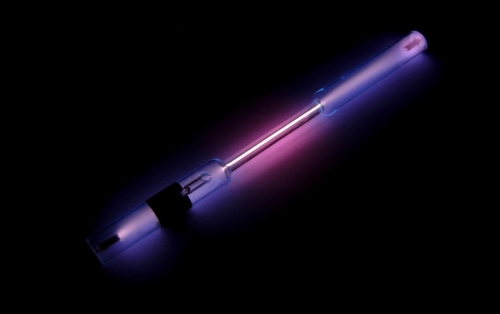
The sintering process for such ceramics is very capricious, because it must be chemically resistant to sodium vapor and must have high transparency so that most of the light is not lost in the walls of the discharge tube. Sodium vapor, which serves as a gas-discharge medium in sodium lamps, produces a bright orange light when illuminated. Because of the presence of sodium in the lamp, the abbreviation DNAT came into use, which means sodium arc lamps.
Advantages and disadvantages of sodium lamps
Sodium lamps are twice as effective as regular lamps daylight similar power - this can be explained by the small size of the emitter, the light rays from which are much more easily directed in the desired direction, and other design features.
In addition, using sodium arc lamps you will be able to recreate much greater illumination. Its ceiling for daylight fixtures reaches 50 watts per square foot, and with the help of sodium lamps you can achieve 3 times more without any problems!

From an economic point of view, sodium lamps are more profitable - they only need to be changed once every six months, and 1 DNAT-400 lamp can successfully replace 20 40 V LDS. It is also much more convenient to work with a medium ballast than with 15 small ones. Since sodium lamps use electricity twice as efficiently, when using them, a certain result is achieved at half the cost.
The efficiency of sodium light bulbs is directly dependent on temperature external environment, and this in turn slightly limits their use, because they shine worse in cold weather. It is also not entirely clear that they are more environmentally friendly than mercury lamps, since most sodium lamps use a compound of sodium and mercury as a filler - sodium amalgam.
Using sodium lamps
Typical objects where sodium lamps are used: highways, streets, squares, long-haul tunnels, airfields, traffic intersections, sports facilities, construction sites, airports, train stations, architectural structures, warehouses and production premises, pedestrian areas and roads, as well as additional lighting sources.
If you want yours personal plot somehow decorate, you can buy sodium lamps, which were found in landscape design its application. Due to the characteristics of sodium lamps, warm and bright orange light, they are used for auxiliary purposes for a unique decorative effect, which simulates open flame or sunset.

Purchasing sodium lamps is useful if the owner grows seedlings and has winter garden, greenhouse or conservatory. Of course, sodium lamps will not replace natural light and sunlight, but your plants will not be affected by the changes. weather conditions and cloudy days will not be affected if the flowers are illuminated with such lamps.
Operating principle of a sodium lamp
Inside the external cylinder of DNAT there is a “burner” - a tube made of aluminum ceramics and filled with rarefied gas, which is created between two electrodes electric arc. Sodium and mercury are introduced into the burner, and an inductive or electronic ballast is used to limit the current.
The mains voltage is not enough to ignite a cold sodium lamp, so the principle of operation of a sodium lamp is to use a special IZU - a pulsed ignition device. Immediately after switching on, it generates voltage pulses of several thousand volts, which are guaranteed to create an arc. The main radiation flux is generated by sodium ions, so their light has a characteristic yellow color.
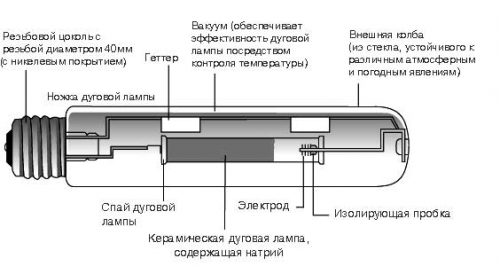
The burner heats up to 1300 degrees Celsius during operation, so air has been pumped out from the external cylinder to keep it intact. For all sodium lamps without exception, when operating, the temperature of the cylinder exceeds 100 degrees Celsius. The lamp shines weakly after the arc occurs, all energy is spent on heating the burner. The brightness increases as it warms up and after ten minutes reaches normal levels.
Types of sodium lamps
If economical operation of light over a long period of time is more important to you, then it is best to purchase sodium lamps low pressure, which are distinguished by high levels of operational reliability, light output over time and energy efficiency.
Sodium lamps are ideal for organizing street lighting because they are capable of emitting the monochrome color familiar to people. yellow, but do not have sufficient transmission of the light spectrum.
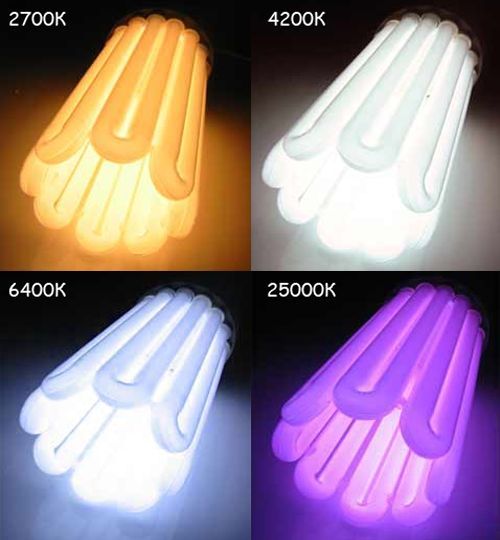
For other purposes, the use of low-pressure lamps is considered difficult because the colors of objects illuminated by such a lamp cannot be distinguished. The color perception of objects indoors is distorted (for example, green turns into dark blue or black), and the design appearance of the premises is lost.
To save money, it is recommended to buy high-pressure sodium lamps. Connecting high-pressure sodium lamps is most suitable for gyms, industrial and commercial complexes. The light emitted by high-pressure sodium lamps allows colors to be distinguished in almost the entire range, except for short wavelengths, in which colors may fade somewhat.
Installation of sodium lamps
Sodium lamps are now widely used in various sectors of the economy, however, due to insufficient transmission of the color spectrum, they are most often used as street lighting. Sodium bulbs, unlike metal halide bulbs, do not care in which position they operate.
However, based on many years of practice, it is believed that it is more effective horizontal position lamps, because it emits the main stream of light to the sides. To connect any HID lamp, a ballast is required. Sodium lamps are no exception in this sense; ballast is required for their “warming up” and normal operation.
Ballast
For sodium lamps, the ballast is a ballast, electronic ballast and pulse ignition device. Undoubtedly, the best ballasts are rightfully considered electronic, which have a number of advantages over inductive ballasts, losing to the latter in cost: currently their price is quite high.
The most common ballasts are ballast inductive chokes, which are necessary to limit and stabilize the current. The necessary ballast, which is connected to the lamp in the required way, is already present in them, so the connection diagram for sodium lamps comes down solely to supplying supply voltage to the terminals of the lamp.

Today, double-winding chokes are outdated, so you should give preference to single-winding ones. Regular throttle domestic production You can buy it at the company for about 10 dollars, and at the market - half the price.
It must be intended specifically for HPS and have the same power as the lamp. It is necessary to install a “original” choke, otherwise the lamp’s service life may be reduced several times, or the light output will drop catastrophically. It is also possible to “blink” when the sodium lamp goes out immediately after warming up, then cools down, and everything happens all over again.
Pulse ignition device
IZUs are required, as described above, to light the lamp. IZU manufacturers produce devices with 2 and 3 pins, so the sodium lamp switching circuit may be slightly different. But usually it is depicted on each IZU case. Of the domestic IZUs, the most convenient is the “UIZU”; it is suitable for lamps of any power and can work with all ballasts.
![]()
In this case, you can place the UIZU next to the ballast and near the light bulb, connecting it to its contacts. Polarity does not play a special role when connecting the ICU, but it is recommended that the “hot” red wire be connected to the ballast.
Noise suppression capacitor
Arc sodium lamps are consumers of reactive power, so it makes sense in some cases (in the absence of phase compensation) to include an interference suppression capacitor C in the sodium lamp circuit, which significantly reduces the inrush current and prevents unpleasant situations. For chokes DNaT-250 (3A), the capacitance of the capacitor should be 35 μF, for chokes DNaT-400 (4.4A) - reach 45 μF. Dry type capacitors with a rated voltage of 250 V should be used.
Connections are usually made thick stranded wire large section, network cable must also count on high current. Make solderings reliable. Tighten the screws tightly, but without excessive force, so as not to break the block.
When connecting sodium lamps yourself, it is worth considering this recommendation - you should not allow the length of the wires that connect the ballast to the sodium lamp to exceed more than one meter.
Security Issues
If you assembled the lamp yourself, make sure that its connection diagram is absolutely correct. If the connection diagram is not drawn on your ballast, or the number of legs on the ballast/IZU does not match the diagram, you should consult with the seller of these parts or an experienced electrician. The consequences of such an error are catastrophic: burnout of one of the 3 elements of the circuit, knocking out the plugs, explosion of the lamp and fire.
If there is grease or dirt on the sodium lamp cylinder, it may burst due to uneven heating immediately after warming up. Therefore, do not touch the lamp with your hands and wipe it with alcohol just in case after installing it in the socket. If drops of water or other liquids come into contact with a switched-on lamp, this provokes an explosion with 100% probability!
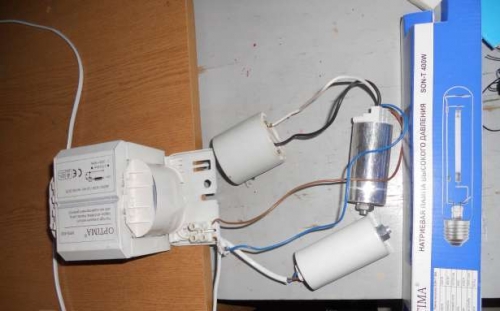
When using a fan, it is worth checking that it blows and rotates where it should. The lamp must be hung securely to avoid falling - a sodium lamp is heavy and can break something if it falls. When repairing a lamp, some measurements should be made with the device turned on - do not do this yourself unless you have sufficient experience working with high voltage devices.
While the sodium lamp is operating, once a month, wipe off dust from the lamp and reflector and check the condition of the fan. It is recommended to change sodium lamps every 4-6 months, since towards the end of their useful life their light output drops significantly.
Sodium lamp malfunctions
As sodium lamps age, they acquire the habit of “blinking”: the lamp turns on, warms up as usual, then goes out unexpectedly, and everything repeats after a while. If you notice this behavior in your lamp, you should try changing the light bulb. If changing the lamp does not help, you need to measure the voltage in the network; maybe it is slightly lower than usual.
If the sodium lamp blinks irregularly, the reason lies in poor contact or power surges in the network. The most unpleasant situation is a short circuit in the ballast between the turns of the winding, then it needs to be changed. Sometimes new lamps may flash, but this goes away after a few hours.
You can often hear the IZU crackling after turning on the lamp (a sign of operation), but the lamp does not even try to light up. This happens most often due to breakdowns in the wire that goes to the lamp from the IZU, or indicates a burnt-out lamp. A broken wire between the lantern and the ballast or a burnt IZU may be to blame.
You can try changing the wire between the lamp and the IZU. It is also worth paying attention to the IZU contacts and their condition. If it doesn't help, change the lamp. If this does not help, turn off the IZU, because it can burn the voltmeter with its impulses, and measure the voltage on the lamp socket - it should correspond to the mains voltage at the DNAT. If there is voltage on the cartridge, change the IZU.
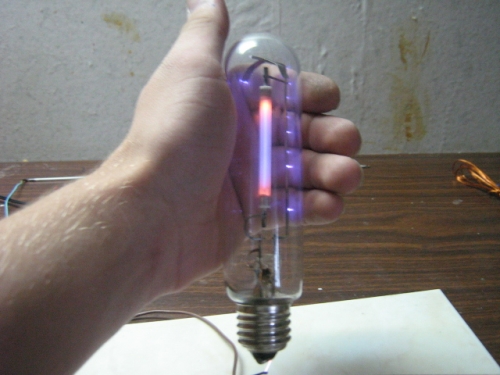
If the sodium lamp shows no signs of life at all: the IZU does not buzz, the lamp does not glow - most likely the contact in the power cord is broken or the fuse is blown out. Maybe the IZU burned out, or a winding break occurred in the ballast - check the ballast, if it is intact, it is worth changing the IZU.
The ballast can be checked with a regular Ohm meter. Their normal resistance is 1-2 ohms. If the indicator is significantly higher, it means that there was a break in the winding or the contact between the connecting block and the winding terminals was broken (tighten the screws).
Everything is more complicated with interturn closure - it affects the resistance DC very little, so it is difficult to detect, and more power is supplied to the lamp than necessary. When a sodium lamp is overpowered, the lamp overheats quickly and goes out, and as a result, “blinking” can also be observed.
Now you know how to connect a sodium lamp! In conclusion, it is worth noting that sodium arc lamps are one of the most effective categories of visible radiation sources, because they are characterized by the highest light output of all gas-discharge lamps known to mankind and a slight decrease luminous flux with a long useful life.
(322
votes, average: 4,83
out of 5)
HPS lamps: a light source that was retired too early.
As we promised, an article about HPS lamps(Arc Sodium Tubular High Pressure). Everyone who has worked or is working in the field of lighting engineering has heard about this monster. But if anyone hasn’t heard, we’ll explain it in simple terms: HPS lamps are like a Kalashnikov assault rifle for lighting streets and illuminating plants - a time-tested and reliable, but not without its shortcomings, light source.
Actually, this article about HPS lamps is more for beginners; material presented competently, but accessible language: without circuit diagrams connection and complete understanding of the basics of maintaining the discharge column in the burner of a HPS lamp. But we are sure that specialists will also like the sketch.

Almost 100% of the world's roads (no one, of course, counted) until recently were illuminated by HPS lamps, until they began to be cut out from their supports in favor of LED lamps. However, even now, experienced designers prefer to stick a sodium lamp into the project out of harm’s way, because LEDs are 1. really more expensive, 2. not that much energy efficient and 3. still unpredictable, because the number is simply overwhelming. But more on that later.

HPS lamps come in different powers - from 50 to 1000 W (rarely, but they are found with a power of 2000 and 4000 W), which seems to hint at their “industrial” use rather than “household”. Basically, HPS lamps are used in lamps for illuminating streets and roads, less often - in production in combination with light sources white light(for example, with lamps on MGL to achieve more warm light and greater energy efficiency). In the most perverted cases, they are put into production in their pure form. And then - before the first injury or the call “where to go.”

But the most indispensable application is lighting greenhouses, or supplementary lighting of plants (which, in fact, is the same thing, but the second is scientific).
Terminology
This is why we don’t like Wikipedia, because what they write there is either superficial and not clear, or boring and with all the details - which is also not clear to the uninitiated. The most offensive thing is that the essence of the name of the HPS lamp is given only as a decoding of the abbreviation, but here everything is much more interesting.
HPS lamps all over the world (except Russia) are called as they should be called - HPS Lamp (High-Pressure Sodium Lamp), that is, high-pressure sodium lamps (HPS). We also call them that, but no one uses this term. In the Soviet Union, when NLVDs first appeared, various factories began to produce them. The modifications and capacities were different and they had to be distinguished somehow.

There were indeed many differences: the shape (ellipsoidal/tubular) and transparency (matte/transparent) of the bulbs, the lamp power (75/150/250/400/600/1000), the presence or absence of mirror coating in one of the hemispheres. So what are the names of NLVD? Soviet made there were a lot. The most common are HPS lamps with various power attachments (150, 250, etc.).

It was something like branding. For example, now in Russia there are DNAT-250 lamps (with a note, “of such and such production”), and in Germany (and all over the world thanks to export, marketing and quality) there is a lamp, for example, VIALOX NAV-T 250 W SUPER 4Y produced by Osram.
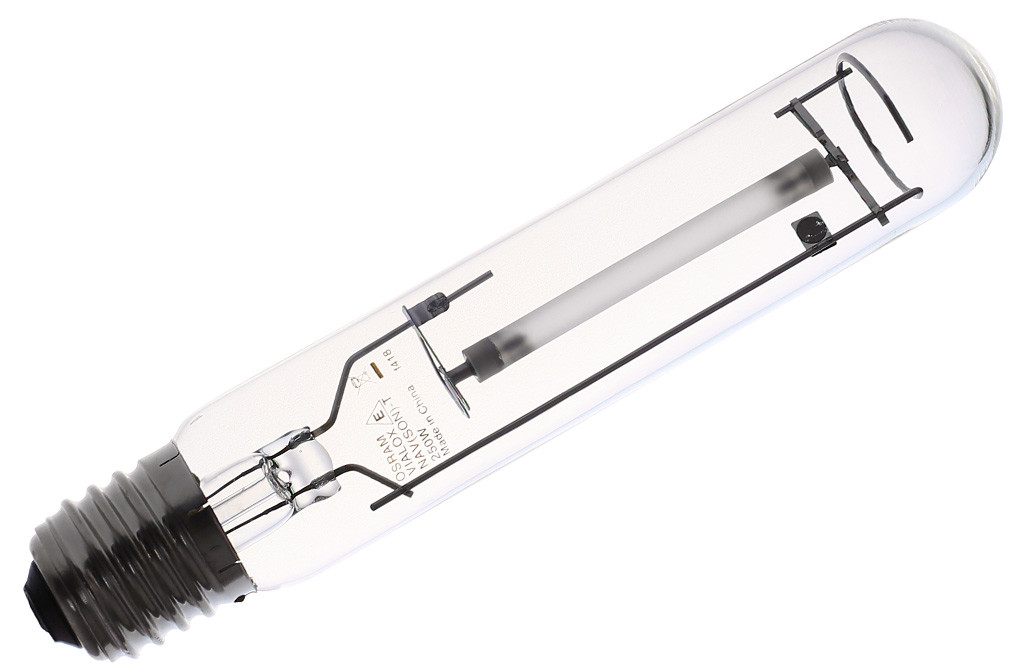
So, by and large, HPS lamps are just variations of the lamp model, not a type of light source. But the type of light source is NLVD, which includes lamps DNaT, DNaZ (with mirror coating) and even DNaS (with a light-scattering bulb, so that it is less blinding). And, except for specialists, few people know this. That's it.

By the way, if anyone is interested, you can look into the lamp museum (the site is in English, but with a lot of pictures) - there are countless different lamps collected here, incl. and sodium, throughout the history of the era of electric lighting. Very informative.
HPS lamp design
In principle, HPS lamps are no more complicated than any gas discharge lamp. On the outside there is a flask made of heat-resistant glass and a base, on the inside there is a burner holder and the burner itself. All.

Connecting a HPS lamp
The connection is also primitive to the point of disgrace, as is the design of the lamp. So we won’t dwell on this for long and will just give one of the most standard schemes connecting the HPS lamp.

Although here it is worth mentioning that in reality there are a huge number of options for connecting a HPS lamp. A compensating capacitor is also a mandatory connection component. As a rule, connection diagrams are indicated on the IZU blocks. But the picture above shows the simplest schematic connection option.
Advantages of a HPS lamp
1. Energy efficiency of HPS lamp
This light source is still considered one of the cheapest and most energy efficient (2016). Yes, yes, you shouldn’t make eyes like that. They are quite competitive with LEDs, incl. and according to the lm/W parameter. Yes, with best representatives industry with a power of 250 W it is quite possible to shoot up to 130 lm/W (proof). And from a lamp - up to 90...110 lm/W, depending on the manufacturer, diffuser, reflector, ballast and quality of the supply network.

Interestingly, the higher the power and luminous flux of a HPS lamp, the higher their light output. For example, there are almost no 50-watt lamps above 80 lm/W. But with DNAT 1000 you can safely get 150 lm/W - that's crazy. Once again, just two years ago such parameters for LEDs in mass production were unimaginable.

It is not entirely correct to simply talk about a lamp without a lamp, because... only in it you can see all the pros and cons of the HPS lamp. The energy efficiency of lamps with sodium lamps is clearly illustrated by the characteristics declared by lamp manufacturers on their websites (they rarely lie). But we also have our own measured data obtained from the laboratory during testing of luminaires for rating:
— - 84 lm/W,
— with GE lamp - 81 lm/W,
— - 87 lm/W.
Now comes the most interesting part. If we talk about direct replacement, i.e. when the old sodium lamp was removed and a new LED was hung in its place, you must understand that a lamp with a 150 W HPS lamp can never be replaced with a 50 or 70 W LED. The same applies to 250 W sodium lamps - they cannot be replaced with a 100 or even 150 W LED (we are talking about ordinary lamps, and not about custom-assembled ones with ideal characteristics and a luminous efficiency of 150 lm/W from a lighting device).
2. Price of a HPS lamp
The cost of a HPS lamp varies from 300 to 10,000 rubles, depending on the power, manufacturer, seller and some other variables. An average 250 W light bulb costs around 1000 rubles (±700). But it’s also not entirely interesting to talk about the price of an abstract HPS lamp. It is interesting to talk about the cost of a lamp as part of a lamp with ballasts (starting and control equipment), a base, protective glass, etc.
In general, the DNAZ lamp, together with its inventor, deserve a separate article. And we will definitely write it. No. Seriously. Apart from the company's own website, you will find almost no information about this lamp. So we'll fix this.
Photosynthesis is the cornerstone of plant nutrition. And the first half of this word “photo” clearly tells us about the participation of light in this process. When growing plants hydroponically at home, you will definitely encounter the need to create artificial lighting for your green spaces. I don’t argue that there are natural lighting conditions that are close to ideal: large windows, sunny side, lack of houses opposite the windows, southern latitudes, eternal summer... But in most cases the need for at least additional lighting artificial light still exists.
And we need to choose what type of artificial lighting to use. In addition to the household criteria for choosing the type of lamp, such as cost, efficiency, ease of use, there is another one for the grower: important criterion- emission spectrum of the lamp. There is already information about spectra on our website, but, in short, the point is that plants need light of certain wavelengths - mainly in the red and blue parts of the spectrum. But lamps differ greatly in this indicator, and most of the lamps existing on modern market, is eliminated precisely due to non-compliance with this requirement. These include incandescent lamps, ultraviolet lamps, most halogen lamps and some others.
Types of plant lamps
But there are lamps that more or less satisfy the needs of plants, and which are successfully used in home and industrial plant growing. These include:
- Some energy saving lamps.
They are ineffective, but they can be used when located close to plants and with a large number of lamps. Different “energy savers” vary in spectrum, so you need to experiment with them and choose those to which plants respond best. - Fluorescent lamps.
There are different spectrums, suitable and not so suitable. In plant growing, it is recommended to use T5 and T8 lamps. They also require close proximity to plants, and large quantity lamps Often used as an addition to the main light, or as the main lighting for growing seedlings. - Light emitting diodes, LED.
Recently appeared on the market and are very promising, but at the moment they are active use constrained by the high cost of lamps. - High pressure mercury lamps, DRL.
They can be used as the main light, but have their drawbacks: low light output and high temperature. - Metal-halogen lamps, MGL, DRI.
Actively used as main and additional lighting. They have a lot of blue light in their spectrum, which is used by plants at the vegetative stage of growth. Therefore, these lamps are good for growing plants that value the green part. - High pressure sodium lamps, HPS.
The most popular and actively used lamps at the moment. The spectrum is well suited for growing fruit-bearing plants. Like other lamps, it also has its drawbacks: a certain lack of blue component of the spectrum (solved by supplementary illumination with other lamps), and strong heating during operation.
Launch of DNAT
Due to its design, the HPS lamp cannot be connected directly to our home electrical network- the mains voltage is not enough to ignite a cold lamp. In addition, the lamp arc current must be limited. Therefore, HPS lamps are used in conjunction with Starting-Regulating Devices (PRA)- electromagnetic ( EmPRA) and electronic ( electronic ballast).
In Western terminology, these devices are called ballasts - Magnetic Ballast and Digital Ballast, respectively. You can read about foreign-made electronic ballasts in, and here we will look at the device and process self-assembly electromagnetic ballast.
Design and assembly of ballasts - starting and regulating apparatus for a HPS lamp
So, the ballast uses only three components:
- Inductive choke. It just limits the arc current. Price from 600 rub, depends on the manufacturer, power. The power of the choke must match the power of the lamp. Those. for a DNAT 250 lamp, we are looking for a 250 W choke in the store.
- IZU is a pulse ignition device. Immediately after switching on, it generates voltage pulses of several thousand volts, which create an arc. Price from 300 rub.. When purchasing, we also pay attention to the power. IZUs have a power range, for example 35-400 W. We make sure that the power of our lamp falls within this range.
- Phase compensating capacitor. This component may be missing, but its use provides additional benefits. Price from 150 rub.. The parameters of capacitors will be discussed below.
When purchasing a choke and IZU, check with sellers whether the products they offer are suitable for use with HPS lamps. According to some information, for HPS lamps and DRI lamps they are used different components. I would be glad to receive a competent opinion on this issue in the comments to this article..
All components can be found on sale in electrical markets. The components are of both domestic and foreign (Israel, Germany) production. On the Internet, as usual, domestic ones are criticized and imported ones are praised.
The ballast circuits look like this:

Options with two- and three-pin IZUs are presented - both are available on sale. The third diagram shows an option using a phase-compensating capacitor (indicated in the diagram WITH). In a circuit with a three-pin IZU, the capacitor is connected in the same way, in parallel. On the IZU and on the inductor you will see similar diagrams, but more detailed, indicating the contact markings of your specific devices. Be sure to follow these markings! If you are careful enough, there should be no problems during assembly.
When assembling and using these circuits, you need to pay attention to which wire the phase is supplied through. Studying materials on the Internet, I came to the conclusion that this important point(if I'm wrong, correct me in the comments). Solving this issue, I marked the plug and socket, indicating the phase on them.
It is also convenient to use the colors of the wires when assembling the circuit. This speeds up installation and eliminates the need to call them. The rules are:
- Working zero (N) – blue, sometimes red.
- Phase (L)– can be white, black, brown.
- Null protective conductor(PE)– yellow-green color.
For connection three wires at one point (zero from the lamp, from the IZU and from the plug), it is convenient to use a three-pin terminal block.
All electrical connections are carried out with thick stranded wire, soldering (if any) must be reliable. The screws in the connecting blocks must be tightened tightly, but without excessive force, so as not to break the block.
This is what my assembled ballast for DNAT 250 looks like:

Capacitor in ballast circuit
You may have noticed that I did not use a capacitor in my circuit. Unfortunately, I simply did not find it for sale. Why do you need a capacitor in the ballast circuit for HPS, since the circuits work without it? The bottom line is that using a phase-compensating capacitor can reduce the load on your home electrical wiring and on the circuit of your lighting device in particular. You will be told in more detail and very clearly about the benefits of using a phase-compensating capacitor in this video.
We select the capacitor capacity for our circuit according to the following table:
Lamp powerCapacitor 220V~50Hz 150 W20 µF250 W32 µF400 W45 µF600 W60 µF1000 W85 µF
Safety
Due to design features HPS lamp, when experimenting with it and its further use, the following precautions should be observed:
- Do not turn off the lamp immediately after turning it on. It should burn for a minute or two. After a short-term shutdown, the lamp “freezes” and does not turn on. To turn it on, you need to unplug the lamp and let it “rest.”
- Provide good ventilation for the lamp. The temperature of a working HPS lamp is much higher than 100 degrees C (according to some sources, up to 1000 degrees!). Therefore, good ventilation is not only a guarantee of the well-being of your “plants”, but also your personal safety. Do not touch the operating lamp or its reflector.
- Try not to touch the lamp at all. Before installation, wipe the lamp clean soft cloth, do not handle the lamp with bare hands. It is best to use cloth gloves. The fact is that due to the same high temperature, any foreign deposit (fats, water) on the lamp bulb can cause it to explode. They write a lot about this on the Internet, but here is a wonderful video on this topic.
- Depending on the power, Ballast can also get very hot- from 80 to 150 degrees. Therefore, you need to somehow solve the issue of protection from high ballast temperatures. For example, isolate the ballast in a reliable fire-resistant casing, prevent paper, fabric, and dry leaves from getting on it.
- Observe general safety precautions when working with electricity. Avoid the possibility of water getting into the ballast, move it away and hang it higher. The wires must have complete insulation; it is better to use special wire for harsh conditions. Remember that at the moment the lamp is ignited, the IZU produces very high voltage pulses. This is in addition to the “regular” 220 volts, which are present throughout the entire circuit.
GORSHKOFF.TV
In this article I have mentioned several times a video from a wonderful YouTube channel GORSHKOFF.TV. Perhaps this is the best popular science (I’m not afraid of this word) channel dedicated to hydroponics that I have ever come across! I highly recommend that you all watch all the videos on the channel, and I’m looking forward to the appearance of new educational materials, and I also express my deep gratitude for this activity personally
